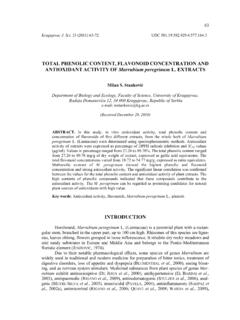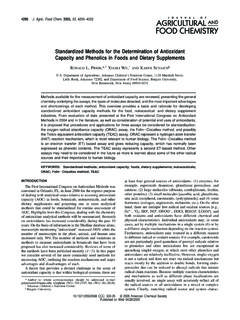Transcription of Use of a Free Radical Method to Evaluate Antioxidant Activity
1 , (1995) Use of a Free Radical Method to Evaluate Antioxidant Activity W. Brand-Williams, M. E. Cuvelier and C. Berset* Laboratoire de Chimie des Substances Naturelles, Ddpartement Science de l'Aliment, ENSIA 1, avenue des Olympiades, 91305 Massy (France) (Received March 11, 1994: accepted June 28, 1994) Tile antiradical activities of various antioxidants were determined using the free Radical , ,1hydrazyl (DPPI-I ). In its Radical form, DPPI-I has an absorption band at 515 nm which disappears upon reduction by an antiradical compound. Twenty compounds were reacted with the DPPI-I and shown to follow one of three possible reaction kinetic types. Ascorbie acid, isoascorbic acid and isoeugenol reacted quickly with the DPPI-I reaching a steady state immediately. Rosmarinic acid and 6-tocopherol reacted a little slower and reached a steady state within 30 rain. The remaining compounds reacted more progressively with the DPPH reaching a steady state from I to 6 h.
2 Caffeic acid, gentisic acid and gallic acid showed the highest antiradical activities with a stoichiometo, of 4 to 6 reduced DPPH molecules pet" molecule of Antioxidant . Vanillin, phenol, y-resort3'lic acid and vanillic acid were found to be poor antiradical compounds. The stoichiometry, for the other 13 phenolic compounds varied from one to three reduced DPPH molecules pet" molecule of Antioxidant . Possible mechanisms are proposed to explain the results. Introduction The oxidation of lipids in foods is responsible for the formation of off-flavours and undesirable chemical com- pounds which may be detrimental to health. antioxidants are used by the food industry to delay the oxidation process. Many different methods (1) have been used to measure the resistance of a lipid to oxidation when in the presence of potential antioxidants . These tests are generally performed in either a lipid or emulsion medium.
3 Autoxidation is a slow, Radical process which proceeds via a chain reaction including induction, propagation and termination steps. During the induction period, alkyl radicals are formed which undergo reaction with oxygen molecules to form hydroperoxides and peroxide radicals during the propaga- tion phase. Termination proceeds via association of two radicals to form a stable adduct. The majority of tests are performed by shortening the induction period of the chain reaction, either by using high temperature or an increased oxygen supply. From these tests, the antioxidative activities of a number of pure compounds and plant extracts have been determined by measuring the oxygen consumption or production of hydro- peroxides or other degradation products. In our laboratory, an accelerated test has been developed (2) which follows the disappearance of methyl linoleate using gas chromatography. Recently, a Method using a different approach has been cited in the literature (3-6).
4 To Evaluate the antioxidative Activity of specific compounds or extracts, the latter are allowed to react with a stable Radical , 2,2-Diphenyi- l-picrylhydrazyl (DPPH ) in a methanol solution. The * To whom correspondence should be addressed. 0023-6438/95/010025 + 06 $ reduction of DPPH as indicated below is followed by monitoring the decrease in its absorbance at a characteristic wavelength during the reaction. In its Radical form, DPPH absorbs at 515 nm, but upon reduction by an Antioxidant (AH) or a Radical species (Re), the absorption disappears. DPPH e + AH ~ DPPH-H + Ae DPPH + Re ~ DPPH-R In this paper we have attempted to explain the results obtained using the DPPH = Method for a number of phenolic compounds as well as ascorbic and isoascorbic acids. The results are compared to those obtained using the methyl linoleate test (2). Materials and Methods Reagents The methanol used was of spectrophotometric grade (990g/L) from Analyticals Carlo Erba (Milano, Italy).
5 2,2-Diphenyl-l-picrylhydrazyl (DPPH 950g/kg), BHT (990g/kg), BHA (980g/kg), isoascorbic acid (980g/kg), ~,-resorcylic acid (980 g/kg) and isoeugenol (980 g/kg) were from Aldrich (St Quentin Fallavier, France). ~-tocopherol (900 g/kg) was from Sigma (St Quentin Fallavier, France). Ascorbic acid (997g/kg) eugenol, gallic acid (990g/kg), phenol (990g/kg) and guaiacol were from Prolabo (Paris, France). Protocatechuic acid, gentisic acid, rosmarinic acid, ferulic acid, vanillic acid, zingerone and caffeic acid were from Extrasynth~se (Genay, France). Vanillin (990g/kg) was a product of Fluka. Apparatus All spectrophotometric data were acquired using a Uvikon 810 Kontron spectrophotometer. Disposable cuvettes (1 cm (~) 1995 Academic Press Limited 25 lwt/vol. 28 (1995) No. 1 l cm x ) from Muller Ratiolab (Dreieich, Ger- many) were used for visible absorbance measurements. Antiradical activities of potent antioxidants by DPPH The Antioxidant activities were determined using DPPH as a free Radical .
6 For each Antioxidant , different concentrations were tested (expressed as the number of moles of anti- oxidant/mole DPPHe). Antioxidant solution in methanol ( ) was added to of a 6 10--Smol/L methanol DPPH e solution. The decrease in absorbance was determined at 515 nm at 0min, 1 rain and every 15 min until the reaction 'reached a plateau. The exact initial DPPH* concentration (CDPPH) in the reaction medium was calcu- lated from a calibration curve with the equation, Abs515n m = 12,509 (CDPPH) -- 10 -3. as deter- mined by linear regression. For each Antioxidant concentration tested, the reaction kinetics were plotted (Fig. 1). From these graphs, the per- centage of DPPH e remaining at the steady state was deter- mined and the values transferred onto another graph show- ing the percentage of residual DPPH e at the steady state as a function of the molar ratio of Antioxidant to DPPH e (Fig.)
7 2). Antiradical Activity was defined as the amount of anti- oxidant necessary to decrease the initial DPPH e concentra- tion by 50% (Efficient Concentration = ECs0 ((mol/L) AO/ (tool/L) DPPHe). For reasons of clarity, we will speak in terms of I/ECs0 or the antiradical power (ARP): the larger the ARP, the more efficient the Antioxidant . Nineteen pure compounds have been tested. Their formulas are given in Fig. 3. 120 I00! t~ '~ 80 .E .E = 60 E "6 40 20 (a) moles ascorbic acid/ mole DPPH ~ A mm 0 ~ ~ A A == -- -- 1 I T ~ I , t 10 20 30 40 Time (min) I00 l (b) moles guaiacol/ t mole DPPH 80 "E 20 I sl , i 0 100 20~ 300 400 Time (min) Fig. 1 Examples of the two observed types of reaction kinetics. (a) Kinetic behaviour of ascorbic acid: (b) kinetic behaviour of guaiacol 100 -- 0 1 2 ECs0 Moles of zingerone/mole DPPH Fig. 2 The disappearance of DPPH e as a function of the number of moles of zingeronc/mole DPPH" OH Z Comp~,unds X Y Z Phenol H H H BHA H C(CHo, OCH~ BHT C(CHo~ C(CHo~ CH~ p-Coumanc actd H H CH = CH COOH Vanillin H OCH~ CHO VaBillic acid H OCH, COOH Isoeugenol H OCH 3 CH = CH - CH:~ Ferulic acid H OCHa CH = CH - COOH Eugenol H OCH 3 CH 2 CH = CH, Zingerone H OCH~ CH 2 - CHzCOCH 3 Guaiacol H OCH ~ H Proto,:alechuic acid H OH COOH Caffetc acid H OH CH = CH COOH Gallic acid OH OH COOH Gentisic acid H COOH OH CH2OH CH2OH H -C -OH HO-C-H !)))
8 ~N==~ 0 H~ O 0 OH COOH HO OH HO OH ascorbic acid isoascorbic acid y-resorcylic acid HO~c OH O-C-CH=CH-~OHo[ OH tr, l'l~ HO--~ CH2-CH-COOH CH3 5-tocopherol rosmarinic acid Fig. 3 Chemical structures of the tested compounds Results and Discussion Antiradical measurements The evolution of the different reaction kinetics depends on the nature of the Antioxidant being tested. Three types of behaviour were observed. In Fig. l(a), an example of rapid kinetic behaviour is shown. Only three of the 20 compounds tested, including ascorbic acid, isoascorbic acid and iso- eugenol reacted rapidly with the DPPH e, reaching a steady state in less than 1 min. The second type of behaviour was intermediate and concerned only rosmarinic acid and ~-to- copherol. For these reactions, the steady state was reached 26 Iwt/vol. 28 11995) No. 1 after approximately 5 and 30 min for rosmarinic acid and ~-tocopherol, respectively.]
9 The 15 remaining compounds reacted more slowly with the DPPH e. An example of their behaviour ( guaiacol) is shown in Fig. l(b), These slower kinetics were all hyperbolic curves taking anywhere from 1 to 6 h to reach a steady state. As indicated in the methods section, the antiradical Activity was evaluated from the plot of the percentage DPPH remaining when the kinetics reached a steady state as a function of the molar ratios of Antioxidant to DPPH (Fig. 2). In contrast to other researchers (4,6,7) who determined the ECs0 after 30 min of reaction time, the antiradical activities were analysed at the steady state. For those compounds which react rapidly with the DPPH e Radical no difference was observed in the ARPs. However, in the case of slower kinetic behaviour, an ARP determined at 30 min would be erroneous because the reaction would still be progressing ( for BHT ARP30mi n = and ARP240min = ; for protocatechuic acid ARP30mi n = and ARPi20min = ).
10 It was therefore decided to analyse the data at the steady state. Another way to analyse the antiradical Activity could be to determine the amount of Antioxidant necessary to decrease the initial DPPH e concentration by 100% (ECIo0). In this case, the classification of the antiradical efficiency would be different and certain compounds tested ( coumaric acid and vanillin) never react with more than 75% of the initial DPPH e, even after 7 h of reaction time and at very high concentrations. Therefore, the classification of the anti- Radical efficiencies has been established from an ECs0 determined as shown in Fig. 2. In Table 1, all compounds are classified in increasing order of ARP according to their kinetic behaviour. Reactions stoichiometm.' The stoichiometry was obtained by multiplying the ECs0 of each Antioxidant by two which gives the theoretical efficient concentration of each Antioxidant needed to reduce 100% of the DPPH e.






